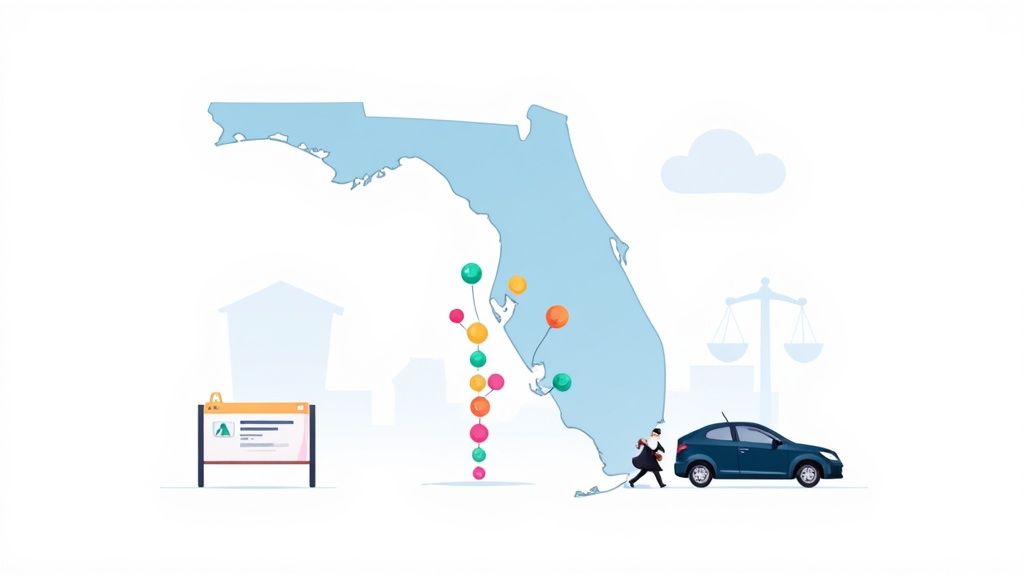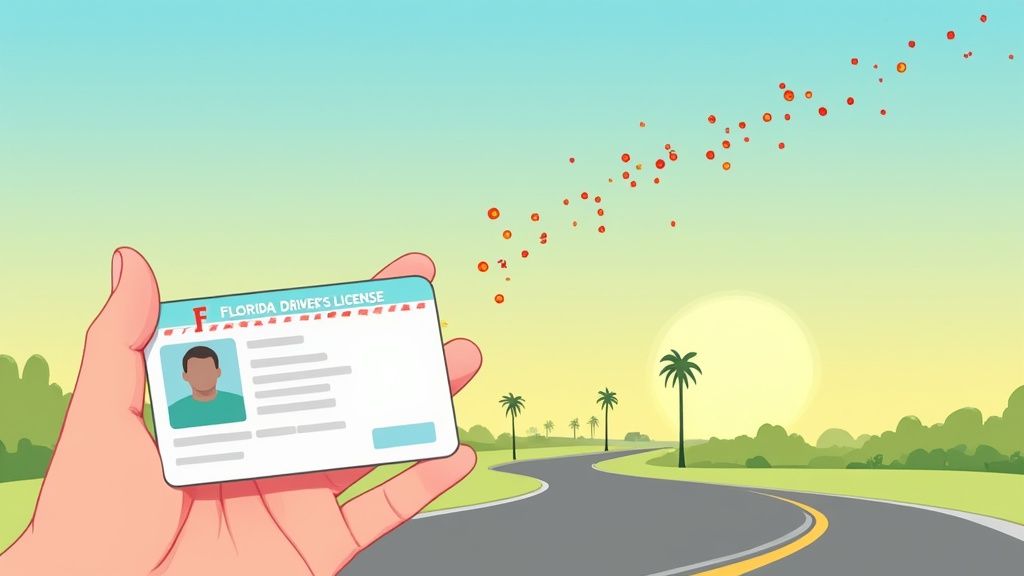Getting a speeding ticket is frustrating. However, what you do right after can make a big difference. Your actions are the first steps to possibly dismiss the ticket.
What to Do After Getting a Speeding Ticket

The minutes after an officer drives away are very important. It is normal to feel angry or anxious. But, the best thing you can do is stay calm and get organized. The ticket and your memory are the foundation for your defense.
If you feel singled out, know that speeding tickets are common. In fact, speeding is a factor in over a quarter of all traffic fatalities. The National Highway Traffic Safety Administration (NHTSA) reported that in 2021, speeding killed 12,330 people.
When you get a traffic ticket, you usually have three choices. Each choice has different results. Therefore, it is important to understand your options before you decide.
Here is a quick breakdown to help you see your options.
Your Three Options for a Speeding Ticket
| Option | What It Means | Potential Outcome |
|---|---|---|
| Pay the Fine | You admit guilt by paying the citation. This is the fastest way to handle it. | Points are often added to your license. As a result, your insurance rates will likely increase. The violation stays on your record. |
| Take a Driving Course | You plead “no contest” and agree to complete a state-approved driver improvement course. | You may avoid points on your license. However, you still have to pay the fine and the course fee. This option is usually limited. |
| Fight the Ticket | You plead “not guilty” and request a court date to challenge the citation. | This is your only chance to get the ticket dismissed. A good outcome means no points, no fine, and no impact on your insurance. |
Choosing to fight the ticket is the only way to get a complete dismissal. This can save you from fines, points, and insurance hikes. If you choose this path, your work starts now.
Carefully Read the Citation
Before you drive away, take a deep breath and read the whole ticket. Do not just look at the fine. You are looking for any mistakes.
- Your Info: Is your name spelled right? Is your address correct? Is your driver’s license number accurate?
- Your Car: Did the officer write the correct make, model, and license plate?
- The Violation: Find the specific law number you are accused of breaking. This is the main charge against you.
- Officer’s Notes: Look for any handwritten notes. They might mention the location, your speed, or the road conditions.
Sometimes, a simple error can help dismiss your case. For instance, a wrong license plate number might be enough for a judge to dismiss the ticket. It is a long shot, but it is worth checking.
Document Everything Immediately
Your memory is best right after the event. As soon as you are safely parked, write down everything you remember. No detail is too small.
Expert Tip: Do not wait. The details you record right after the stop are your most valuable asset. If you wait, you might forget a key piece of information that could help you in court.
Try to answer these specific questions:
- Where were you? Note the street, the nearest cross-street, and which way you were going.
- What were the conditions? Was it sunny or raining? Was traffic heavy or light? Were there any things blocking the road?
- What was your speed? What did your speedometer show? Were you moving at the same speed as other cars?
- What was said? Think about the conversation with the officer. What did they say? What did you say?
These notes are your personal record of what happened. If you go to court, this document will help you present a clear story.
Deciding Your Best Strategy for Dismissal
So, you have a speeding ticket. First, take a breath and make a plan. You can go to court to fight the ticket. Or, you can take a defensive driving class.
There is no single right answer. The best path for you depends on your ticket, your driving record, and how you feel about court. Fighting the ticket is the only way to get it thrown out completely. This means no fine and no points. But, it is a risk. It takes time and effort, with no promises.
On the other hand, taking a driver improvement course is often a safer choice for keeping your record clean.
Is a Driver Improvement Course an Option for You?
A driver improvement course can be a powerful tool. If you complete the course, you can often keep the points from a moving violation off your license. The big benefit here is that it helps stop your insurance company from raising your rates.
But not everyone can use this option. You must be eligible.
Generally, you can take a course if:
- You do not have a commercial driver’s license (CDL).
- Your ticket was for a non-criminal moving violation.
- You have not taken a course for a ticket in the last 12 months.
- You have used this option less than five times in your life.
If you meet these rules, you can tell the court you want to take the course. You will still pay the ticket fine. However, the money you save on insurance can be very large. To learn about specific rules, you should check your state’s official government website.
This chart can help you decide if it makes more sense to fight your ticket.

As you can see, how fast you were going and the proof you have are big factors in your decision.
When It Makes Sense to Fight the Ticket
While a defensive driving class is a good choice for many, sometimes court is the right move. If you believe you have a strong case, challenging the ticket could get it dismissed. Maybe you have proof you were not speeding. Or, you found a big mistake on the ticket itself.
For example, maybe your dashcam video clearly shows you were driving under the speed limit. Or, perhaps the officer wrote down the wrong street. This is the kind of strong evidence that can build a powerful defense.
Remember, fighting a ticket is your right. With good preparation, you can win in court. Ultimately, your goal is to pick the strategy that best protects your driving record and your money.
Building a Strong Case for Traffic Court

If you decide to fight your ticket in court, your preparation is key to success. Just showing up and hoping for the best is not a good plan. It will likely lead to failure.
Think like a detective. Your job is to gather all the evidence you can. This will help you create a logical argument for the judge.
This process should start as soon as possible. After the traffic stop, go back to the location. You need to see the scene as an investigator. Look for details that could weaken the case against you.
Gathering Your On-Site Evidence
What you find at the scene can change the game. Use your phone to take photos and videos from many angles.
Here is what you should look for:
- Signs: Are the speed limit signs easy to see? Are they faded, blocked by trees, or missing? Take a picture.
- Road Conditions: Look for anything that could affect traffic or an officer’s reading. Potholes, faded lane marks, or construction zones are all important.
- Officer’s View: Try to find where the officer was. Stand there yourself. Did they have a clear view of your car? Or were there curves, hills, or other cars in the way? A photo from their spot can be strong evidence.
This is not just about what you remember. It is about creating a visual story. A photo of a speed limit sign hidden by a tree is much better than just saying, “I couldn’t see it.”
Requesting Official Documentation
Your own investigation is just the beginning. You also have the right to ask for evidence from the government. This is called “discovery.”
Ask for two key things: the officer’s notes from the stop and the maintenance records for the speed-detection device (radar or laser gun).
The officer’s notes show their side of the story. You can compare them to your notes. But the real potential is in the calibration logs. If the radar gun was not maintained or checked recently, its readings might be unreliable. This single detail has helped get many tickets dismissed.
Interestingly, fighting a ticket does more than give you a chance at dismissal. Some studies show that going to court can be a stronger motivation against future speeding than just paying a fine. You can learn more about road safety and driver behavior from resources like the Governors Highway Safety Association (GHSA).
Organizing Your Defense
Once you have your photos, notes, and documents, it is time to put it all together. Create a timeline of what happened. Organize your evidence to support your story.
If your defense is about a blocked sign, have those photos ready. A well-organized case shows the judge you are serious.
Remember, a strong defense is built on facts, not feelings. Your goal is to create reasonable doubt. By carefully building your case, you give yourself the best possible chance to walk out of court with a dismissal.
Navigating the Traffic Courtroom
Walking into a courtroom can feel scary. But, traffic court is not as dramatic as it is on TV. It follows a standard process. Knowing this process beforehand can help you feel less nervous.
First impressions matter. Therefore, treat your court date like a serious interview and dress professionally. When you speak, always call the judge “Your Honor.” A calm, respectful attitude shows you are taking this seriously.
The hearing will follow a set order. The state will go first. The officer or a prosecutor will explain why they gave you the ticket. Then, it will be your turn.
The Flow of a Typical Hearing
This is the moment your preparation pays off. You will get to present your side of the story. This usually happens in a few stages.
- Telling Your Story: You will have a chance to say what happened. Stick to the facts you wrote down earlier. Speak calmly and clearly.
- Questioning the Officer: You have the right to ask the officer questions. This is not a time to argue. Instead, it is a chance to find issues or clarify details.
- Presenting Your Proof: Now you can show the judge your evidence. This includes photos of a hidden sign, a diagram of the road, or your vehicle’s maintenance records.
- Making Your Final Point: You will end with a short closing statement. Briefly review the key facts that support your case. Then, politely ask the judge to dismiss the ticket.
How to Present Your Case with Confidence
Your main goal is to create reasonable doubt. Was the officer’s view really clear? Was their equipment working right? Focus on real evidence. For example, instead of saying, “I felt like I was driving safely,” present a fact. You could say, “Your Honor, as this photo shows, the 45-mph speed limit sign is completely hidden.”
The most important advice is to stay calm. It can be hard to listen to the officer’s story, but do not interrupt. Wait for your turn. Losing your temper is the fastest way to lose trust with the judge.
Common Defenses Against Speeding Tickets
To give you a better idea, here are common legal arguments used to fight speeding tickets. It also shows the proof you will need for each one.
| Defense Strategy | Description | Required Evidence |
|---|---|---|
| Challenging the Officer’s View | Arguing that the officer’s view was blocked by hills, curves, or other cars. | Photos from the officer’s viewpoint, road diagrams, or dashcam video. |
| Necessity or Emergency | Claiming you had to speed to avoid a more serious danger, like a reckless driver. | Your testimony, witness statements if possible, or dashcam video of the event. |
| Faulty Equipment | Questioning the accuracy of the radar or laser device used to measure your speed. | The device’s calibration and maintenance records, requested through discovery. |
Building a defense around one of these strategies means you must do your homework. You need to gather solid proof. Just stating your case is not enough. You must back it up with evidence.
Exploring Alternative Resolutions and Fines

Sometimes, the best result is not a total dismissal but a smart compromise. Not every speeding ticket case must end with a “guilty” or “not guilty” decision. There are middle-ground options that can protect your driving record and insurance costs.
Many drivers do not know that you can often negotiate with the prosecutor. This can happen right before your hearing. It is a chance to get a better outcome, like pleading to a lesser charge.
Negotiating for a Lesser Charge
A common strategy is to ask the prosecutor to change the speeding ticket to a non-moving violation. This could be something like a broken taillight. These types of infractions do not add points to your license.
This approach often helps everyone. The court gets its fine. And you avoid the points that raise your insurance. The key is to be prepared, respectful, and direct. If you have a clean driving record, mention it. It is your best bargaining chip.
State Spotlight: California’s Traffic Violator School
In some states, you can choose to attend a driving course to keep a ticket confidential. Let’s look at California as an example.
Under California Vehicle Code sections 1808.7 and 42005, eligible drivers can complete a Traffic Violator School (TVS) course. If you are eligible and complete the course, the conviction will be masked from your public driving record. This means your insurance company generally will not see it. You can learn more about the rules at the official California Courts Self-Help Guide.
Using Alternatives to Your Advantage
Taking advantage of these alternatives means you have to be proactive. Whether you are making a deal with a prosecutor or asking a judge for an option, your goal is the same: reduce the damage. A little smart preparation can make a big difference in keeping your record clean.
Taking a Driver Improvement Course
For many drivers, the simplest way to handle a speeding ticket is to take a driver improvement course. It is a smart move. It tackles the two biggest problems from a citation: points on your license and higher insurance rates.
Think of it as taking control of the situation. Instead of risking it in court, a driver improvement course gives you a guaranteed good result. It is often the best answer for anyone trying to make a speeding ticket’s problems go away.
The Real Advantages of a Driving Course
The benefits are clear and happen right away. When you complete a state-approved course, you solve two major problems at once.
First, you avoid getting points on your driving record for that violation. This is very important for keeping your license clean. It also helps you avoid a possible suspension later.
Second, many state laws prevent your insurance company from raising your rates because of that one ticket. This can easily save you hundreds of dollars over the next few years.
Are You Eligible to Take a Course?
This option is not for everyone. States have specific rules about who can take a course to dismiss a ticket.
- You usually cannot have a Commercial Driver’s License (CDL).
- Your ticket must be for a non-criminal moving violation.
- You probably have not taken a course for another ticket in the last 12 months.
- There is often a lifetime limit on how many times you can use this option.
If you meet the rules, you must notify the Clerk of Court in the county where you got the ticket. Remember, you still have to pay the fine. But the long-term savings and a clean record usually make it the right choice.
Speeding Ticket FAQ
Getting a ticket from an officer is never fun. It always leaves you with many questions. Let’s answer some of the most common ones.
Will a speeding ticket add points to my license?
Yes, it will if you just pay the fine. The number of points added to your record depends on how fast you were going over the speed limit. Each state has its own system. For example, some states add 3 points for going 1 to 15 mph over the limit. Others might add 4 points for going 16 mph or more over the limit. Too many points in a short time can lead to a license suspension.
How long do points stay on my record?
Points from a traffic ticket usually stay on your driving record for a few years. For instance, in many states, points last for 36 months, or three years. Even after the points expire, the violation itself can stay on your record longer. Your insurance company may be able to see it for several years. You can check your driving record status on your state’s Department of Motor Vehicles (DMV) website.
How many times can I use a driving course to remove points?
Most states let you use this option a few times. You can often take a driver improvement course to remove points once every 12 to 18 months. However, there is usually a lifetime limit. For example, some states limit you to five times over your entire driving career.
What happens if I just ignore the ticket?
Do not just put the ticket away and forget about it. That will make a bad situation much worse. If you miss the deadline on the ticket without taking action, the state will likely suspend your driver’s license. Then, you will have to pay extra fines and fees to get your license back. You must always choose a path: pay the fine, sign up for a course, or schedule a court date. For more information on traffic safety, the U.S. Department of Transportation (USDOT) is a great resource.
Ready to keep your driving record clean? A state-approved defensive driving course is often the simplest way to prevent points and insurance hikes from a speeding ticket. Sign up today and protect your license. Register Now





